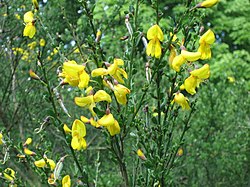Broom (shrub)
Brooms are a group of evergreen, semi-evergreen, and deciduous shrubs.
| Broom | |
|---|---|

| |
| Common Broom, Cytisus scoparius | |
| Scientific classification | |
| Kingdom: | |
| Division: | |
| Class: | |
| Order: | |
| Family: | |
| Subfamily: | |
| Tribe: | |
| Genera [1] | |
| |
All the brooms and their relatives (including Laburnum and Ulex) grow in Europe, north Africa and southwest Asia. The greatest diversity one can find in the Mediterranean region. Many brooms (though not all) are fire-climax species, adapted to regular stand-replacing fires which kill the above-ground parts of the plants, but create conditions for regrowth from the roots and also for germination of stored seeds in the soil.
The most familiar is common broom,[2] that grows in northwestern Europe. One can find it in sunny sites, usually on dry, sandy soils. Like most brooms, it has apparently leafless stems that in spring and summer are covered with golden-yellow flowers. In late summer, its pea-pod like seed capsules burst open, often with an audible pop, spreading seed from the parent plant. It makes a shrub about 1–3m tall, rarely to 4m. It is also the hardiest broom, tolerating temperatures down to about -25 °C.
The brooms belong to the subfamily Faboideae of the legume family Fabaceae, mainly in the three genera Chamaecytisus, Cytisus and Genista, but also in five other small genera (see box, right). All genera in this group are from the tribe Genisteae (syn. Cytiseae). These genera are all closely related and share similar characteristics of dense, slender green stems and very small leaves, adaptations to dry growing conditions. Most of the species have yellow flowers, but a few have white, orange, red, pink or purple flowers.
Folklore change
A traditional rhyme from Sussex says: "Sweep the house with blossed broom in May/sweep the head of the household away." Despite this, it was also common to include a decorated bundle of broom at weddings. Ashes of broom were used to treat dropsy, while its strong smell was said to be able to tame wild horses and dogs.
Gallery change
-
Common broom (Cytisus scoparius).
-
Genista hirsuta in flower.
-
Dyer's broom (Genista tinctoria).
-
French broom (Genista monspessulana) in flower.
-
Common broom (Cytisus scoparius).
References change
- ↑ ILDIS Version 6.05
- ↑ (Cytisus scoparius, syn. Sarothamnus scoparius)
- Mabey, Richard Flora Britannica, Sinclair-Stevenson, London, 1996, ISBN 1-85619-377-2
- Royal Horticultural Society's plant database Archived 2007-03-11 at the Wayback Machine (Accessed 20:53, 29 October 2006 (UTC))